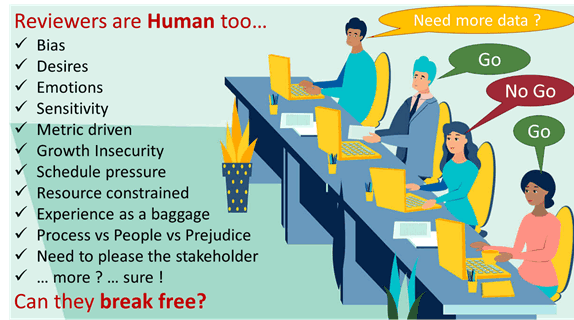Managing Risk in an Innovation Project – Part 2

Can you see the role of human factors in a gate review?
Really? In spite of a well-defined stage-gate process for managing innovation, projects that deserve to be discontinued (fail-fast) pass through the gates and fail-late, causing huge losses and sometimes the entire business. After all gate-keepers are human, and subject to emotional interference.
Suggest reading part-1 at Managing Risk in an Innovation Project
What Makes a Stage-Gate Process Interesting?
Like any organizational system, the gated process does not always work as intended. It is a highly emotional event, irrespective of objectivity designed in the process. Let us look at some of the issues that make it interesting.
Applicability
One must ask a question if a given project is right for stage-gate process or not? Sethi and Iqbal[1] argue that Stage-Gate controls have the potential of restricting learning in a new product development project and thus hurting the performance of novel new products. They specifically observed through data, that control on new product development exercised through rigorous gate review criteria, increases project inflexibility, which in turn leads to increased failure to learn.
Success Metrics
Sometimes, the management chooses a metric around increasing the first pass yield of gated reviews. That is not a good practice. It drives many wrong behaviors: (a) a tendency to pick low-risk ideas/projects to begin with, (b) to keep working to perfection, and (c) the review team’s bias towards a ‘GO’ outcome. That is all counter to innovation and the purpose of a gated review. You want to fail fast and learn fast. It is OK to track, but do not set a goal for yield.
Schedule pressure creates a tendency at compromise marginal situations, sometimes take decision with insufficient data or under-estimate the risk. And if there is a sense of urgency or a need to meet a certain specific performance metric, the entire interpretation of the data gets skewed.
Human Bias
Decision making at the gate review gets effected by bias from various directions. The reviewers can get emotionally vested with the idea and progress based on watching it evolve with their input at previous gates. Experience creates an anchor bias to previous success stories and traditional ways of doing things. Trying to keep the big boss happy, can sway decisions in one direction. Opinions of certain well recognized individuals carries more weight than data-based evidence.
Individual biases also play a role in team dynamics, if the review team chair is not able to handle conflict.
Delicate Engagement
Continuous engagement of review team with the project, even when limited to reviews, leads to a 2-way entanglement. The project team learns how the review team thinks and develops ways to influence the outcome of the gate review. The review team gets empathically attached to the project (& team) and bias towards their earlier feedback. Since the gate committee is not a machine devoid of emotions and biases (yet), they will find it incredibly hard to stop or kill a project in line with the changing PESTEL landscape. It is thus important to bring back a higher authority at later stage gates into the review mix, who were involved in the original approval of the project and can objectively look at the project against the original success criterion.
Personal Insecurity
A gated process often comes across as a threat to career progression or job security. Managers feel uncomfortable at the idea of a No-Go outcome. Management must foster a project team environment of mutual trust and cooperation, an environment that is low on personal conflict, power struggles, surprises, unrealistic demands, and threats to personal and professional integrity. After effects should not include unnecessary inferences to performance appraisals, tight supervision, restriction of personal freedom and autonomy, and overhead requirements.
In Summary,
The stage-gate process is designed to minimize cost and risk of innovation project through synergy and alignment of expectations. The well-defined process (a) Identifies the makeup of a review team and lays out the decision criteria upfront, (b) Provides a forum and timing to discuss and approve any scope changes, (c) Clarifies and adapts the roles & responsibilities during execution, (d) Facilitates informed decision making for the continuation of the project based on the availability of resources, business case, and risk analysis, (e) Identifies intellectual property and other business protection needs. However, for the process to deliver to its promise effectively, the organization must deliberately create an environment of healthy conflict at the Gate reviews. The review team must be
- Competent to make the right decisions, despite the emotional attachment with concept,
- Empowered to judge and stop or redirect a project, despite business pressures, and
- Objective to minimize bias and emotional interference.
Good gate reviews are a work of art and science.
If you like this blog post, you will like my book – “Inspiring Next Innovation Value Chain” available on Amazon.
If you wish to engage with me in a conversation, on important innovation topic, please register for our monthly sessions at www.inspiringnext.com/events
[1] Stage-Gate Controls, Learning Failure, and Adverse Effect on Novel New Products, Rajesh Sethi and Zafar Iqbal, Journal of Marketing, Vol. 72, No. 1 (Jan., 2008), pp. 118-134 (17 pages)

